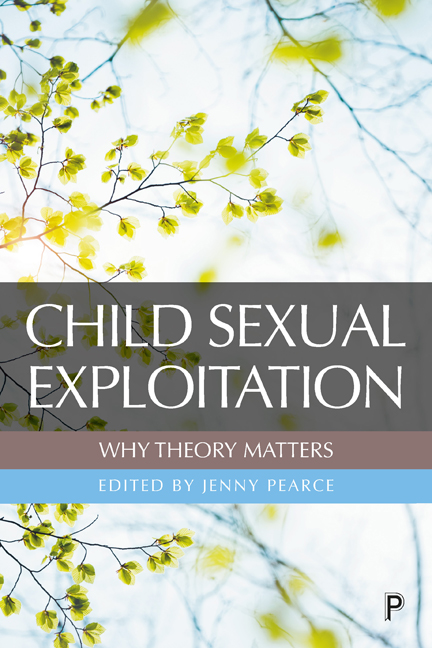Book contents
- Frontmatter
- Contents
- List of Figures and Tables
- Notes on Contributors
- Editor’s Acknowledgements
- Foreword
- 1 Bringing Theory Home: Thinking About Child Sexual Exploitation
- 2 Moving Beyond Discourses of Agency, Gain and Blame: Reconceptualising Young People’S Experiences of Sexual Exploitation
- 3 Child Sexual Exploitation, Discourse Analysis and why we Still Need to Talk About Prostitution
- 4 Contextual Safeguarding: Theorising the Contexts of Child Protection and Peer Abuse
- 5 ‘Losing Track of Morality’: Understanding Online Forces and Dynamics Conducive to Child Sexual Exploitation
- 6 Understanding Adolescent Development in the Context of Child Sexual Exploitation
- 7 Some Psychodynamic Understandings of Child Sexual Exploitation
- 8 Understanding Trauma and its Relevance to Child Sexual Exploitation
- 9 Social Support, Empathy and Ecology: A Theoretical Underpinning for Working with Young People who have Suffered Child Sexual Abuse or Exploitation
- 10 Using an Intersectional Lens to Examine the Child Sexual Exploitation of Black Adolescents
- 11 What’s Gender Got to do With It? Sexual Exploitation of Children as Patriarchal Violence
- 12 Understanding Models of Disability to Improve Responses to Children with Learning Disabilities
- 13 Some Concluding Thoughts
- Index
4 - Contextual Safeguarding: Theorising the Contexts of Child Protection and Peer Abuse
Published online by Cambridge University Press: 10 March 2021
- Frontmatter
- Contents
- List of Figures and Tables
- Notes on Contributors
- Editor’s Acknowledgements
- Foreword
- 1 Bringing Theory Home: Thinking About Child Sexual Exploitation
- 2 Moving Beyond Discourses of Agency, Gain and Blame: Reconceptualising Young People’S Experiences of Sexual Exploitation
- 3 Child Sexual Exploitation, Discourse Analysis and why we Still Need to Talk About Prostitution
- 4 Contextual Safeguarding: Theorising the Contexts of Child Protection and Peer Abuse
- 5 ‘Losing Track of Morality’: Understanding Online Forces and Dynamics Conducive to Child Sexual Exploitation
- 6 Understanding Adolescent Development in the Context of Child Sexual Exploitation
- 7 Some Psychodynamic Understandings of Child Sexual Exploitation
- 8 Understanding Trauma and its Relevance to Child Sexual Exploitation
- 9 Social Support, Empathy and Ecology: A Theoretical Underpinning for Working with Young People who have Suffered Child Sexual Abuse or Exploitation
- 10 Using an Intersectional Lens to Examine the Child Sexual Exploitation of Black Adolescents
- 11 What’s Gender Got to do With It? Sexual Exploitation of Children as Patriarchal Violence
- 12 Understanding Models of Disability to Improve Responses to Children with Learning Disabilities
- 13 Some Concluding Thoughts
- Index
Summary
Introduction
When young people are sexually harassed or assaulted by their peers they experience an intrusion and, in varying ways, are harmed (Turner and Ormrod 2008; Barter 2009; Firmin 2017a). To this extent peerviolence is abuse. The absence of adequate protections from (sexual) abuse is considered a breach of a child's rights – and as such, as a ‘child protection issue’, requires a statutory intervention (UN 1989; DfE 2018b). In response, a number of countries have established child protection systems that invariably seek to reduce the likelihood of abuse and increase safety through intervention with, or support to, families (Corby et al 2012; Parton 2014). Yet peer abuse rarely occurs within families and therefore sits beyond contexts that are overseen, or influenced, by child protective services (Firmin 2017a; Barter 2009; Smallbone et al 2013). In short: child protection systems have developed to protect children who experience abuse within families, or by adults connected to their families – while peer abuse, which is also a child protection issue, largely manifests within peer relationships which themselves form in school, community and online contexts that exist beyond traditional child protection systems. In this chapter, the extra-familial dynamics of peer abuse are presented against the familial parameters of child protection. Analysed through the constructivist structuralist concepts offered by Pierre Bourdieu (1992), cumulative data from a multi-study programme into extra-familial abuse provides a roadmap towards identifying the components of a contextual account of, and response to, peer abuse. Through this process, it is possible to bridge the gap between the field of child protection and the social fields of peer groups by theorising and testing a new approach to extrafamilial child protection – Contextual Safeguarding. In so doing the chapter explains a framework through which peer abuse can be both perceived, and responded to, as a child protection issue.
The theory: constructivist structuralism – social field, capital and habitus The findings of this chapter have been produced by examining peer abuse and child protection systems through a lens of Bourdieu's Constructivist Structuralism (Bourdieu 1992). According to Constructivist Structuralism there is a reflexive relationship between structure and agency.
- Type
- Chapter
- Information
- Child Sexual Exploitation: Why Theory Matters , pp. 63 - 86Publisher: Bristol University PressPrint publication year: 2019



